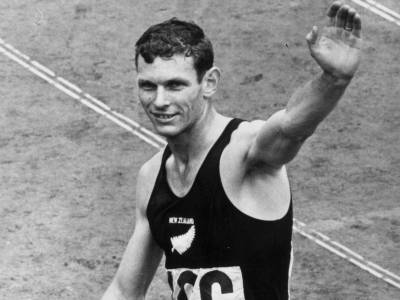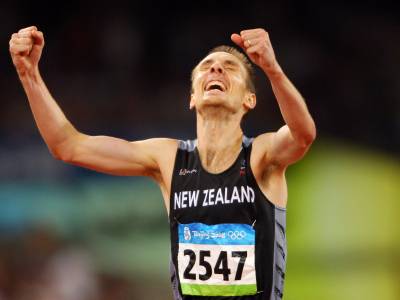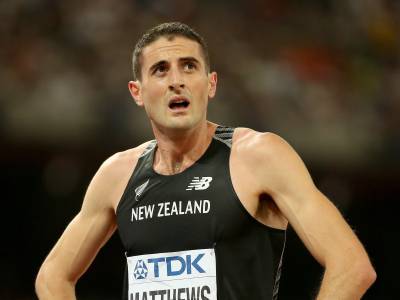By Dr Micheal Warren
Welcome to the First blog of the Olympic year. Lausanne has just hosted the third Youth Winter Olympic Games where 20 Kiwi athletes took part and won one gold and three bronze medals.
Looking ahead, it's less than six months until the Tokyo Olympic Games get underway. The next few months are crucial as The New Zealand Team begins to take shape with the New Zealand Olympic Committee announcing the next generation of Olympians.
While the next generation of Olympians are striving to write the next chapter of Olympic history, this month’s blog will look back to perhaps New Zealand’s greatest Olympian, Sir Peter Snell, focussing on his exploits the last time Tokyo hosted the Olympic Games in 1964.
Tokyo Update – Olympic Stadium Opens as New Zealand Team Continues to Grow
Prior to Christmas the Tokyo Olympic Stadium officially opened with eight-time Olympic champion Usain Bolt taking part in an exhibition relay race alongside Paralympic athletes, in the first public event at the 60,000-seater stadium.
In diving, Lizzy Cui won the 3m springboard at the Oceania Diving Championships, qualifying New Zealand at the spot. Cui competed at the 2016 Olympic Games in Rio, finishing in 24th place, and will be looking to improve on this at the Tokyo Olympics. Dame Valerie Adams also qualified to compete in her fifth Olympic Games. The three-time Olympic medallist threw 18.65m at the Potts Classic in Hastings, qualifying for the Tokyo Olympics. No one would bet against Adams winning her fourth Olympic medal when the shot put final takes place on August 2.
New Zealand’s Legendary Olympian – Sir Peter Snell – the week in Tokyo
On December 14, New Zealanders woke to the news that Sir Peter Snell had passed away peacefully at his home in Dallas, Texas. Snell was born in the small Taranaki town of Opunake on December 17, 1938. It was two years to the day earlier that I visited Snell’s statue in the town of Opunake.

The statue sits at the centre of the main street in Opunake and is a symbol of the running power that Snell possessed.
Snell’s place in history was cemented in mid-October 1964 at the Tokyo Olympic Games. This blog will focus on Snell’s dominance in Tokyo. Snell had a gruelling schedule, competing in six races over the space of eight days.
14 October 1964 – 800m heat
Snell lined up in the fourth heat of six and cruised through in a time of 1:49.6 ahead of Jerome Francis Siebert (USA), Jacques Pennewaert (Belgium), and Abram Krivosheev (Soviet Union) who also qualified for the semi-finals.
15 October 1964 – 800m semi-final
Snell lined up in the first of three semi-finals, needing to finish in the first two to automatically secure a spot in the final. Once again Snell cruised through in a time of 1:46.9 ahead of Siebert (USA) and Pennewaert (Belgium) who also qualified as one of the fastest losers. Snell was safely through to the final.
16 October 1964 – 800m final
Snell started the 800m final as the favourite. The defending Olympic champ understood that burden. In an interview post games, Snell stated “at Tokyo, I’m expected to win. It was the world record holder, and no one had approached my time. It was a question. Do I still have it? I was not absolutely sure, especially when racing out of season.” The final took place at 4.40 pm and after the start, Kenyan Wilson Kiprugut went into the lead. After 400m Snell was sitting patiently in fifth place. Snell was boxed in and unable to get clear. Snell decided to ease off to let the field go past, before surging down the back straight. One Snell surged, he would not be beaten, running away to win the gold medal in an Olympic record time ahead of Bill Crothers of Canada and Kiprugut in who won the silver and bronze medals respectively. In winning bronze, Kiprugut became the first Kenyan to win an Olympic medal, beginning the tradition of Kenyan dominance in athletics long-distance events. Of the victory in Toyko, Snell stated: “in Rome, it was a dream. In Tokyo, it was relief.”
17 October 1964 – 1500m heat
Snell had little time to bask in the glory of defending his 800m Olympic title when he lined up in the heats of the 1500m on 17 October. Snell lined up in the third of four heats and qualified in fourth place alongside Kipchoge Keino (Kenya), Wolf-Dieter Holtz (Germany), and Tom O'Hara (USA). While only finishing in fourth, it was enough to qualify through to the semi-finals while saving energy for his next race.
John Davies also qualified safely in the first heat, finishing in second place.
19 October 1964 – 1500m semi-final
There were two semi-finals in the 1500m with Snell lining up in the first. Needing to finish in the first four, Snell did it in style winning the race in a time of 3:38.8 ahead of Witold Baran (Poland), Josef Odložil (Czechoslovakia) and Michel Bernard (France). In the second semi-final, John Davies crossed the line in third place to also qualify for the final.
21 October 1964 – 1500m final
It was almost a full stadium when the 1500m final took place at 1.20 pm on Wednesday, October 21, 1964. Snell and Davies lined up in the final, with expectations high on Snell that he could do the double and win the 1500m. After the gun, Michel Bernard from France took the lead and led through the first 300m. Davies and Josef Odložil of Czechoslovakia led through the next couple of laps. Davies still led with 300m remaining. On the back straight, Snell took off and shot to the lead. Snell made it look easy as he breezed past Davies and Odložil to win his second gold medal of the games. Odložil won the silver medal, and Davies hung on to win bronze, holding off a fast-finishing Alan Simpson of Great Britain. Snell won by 1.5 seconds, the second-biggest margin in Olympic history. During the final, New Zealand came to a standstill. Parliament almost ceased business and once the final was concluded, Prime Minister Keith Holyoake called a point of order to announced that “Peter Snell has just won the 1,500m by seven or eight yards.”
Snell’s Legacy
After winning double gold in Tokyo, Snell retired from the sport in 1965 and went on to complete a PhD in exercise physiology from Washington State University. Snell joined the University of Texas Southwestern Medical Center at Dallas as a research fellow in 1981. Snell became an associate professor in the Department of Internal Medicine and also director of their Human Performance Center. A member of the American College of Sports Medicine, Snell was honoured in 1999 as an Inaugural Inductee, International Scholar, into the Athlete Hall of Fame, University of Rhode Island.
Snell was voted New Zealand’s athlete of the century in 2000 and was knighted soon afterwards.
The New Zealand Sports Hall of Fame in Dunedin has on display one of Snell’s Olympic medals from Tokyo 1964, and in 2017, Snell donated his two other Olympic gold medals and other memorabilia to Te Papa. Now that Snell has passed, it is up to us to ensure the legacy of Snell lives on.
Spare a thought for Snell when sitting down to watch the 800m and 1500m finals in Tokyo and know that other than Albert Hill from Great Britain in 1920, no other Olympian has repeated his feats from Tokyo of winning both the 800m and 1500m. An impressive effort that is unlikely to ever be repeated.

Tweet Share



